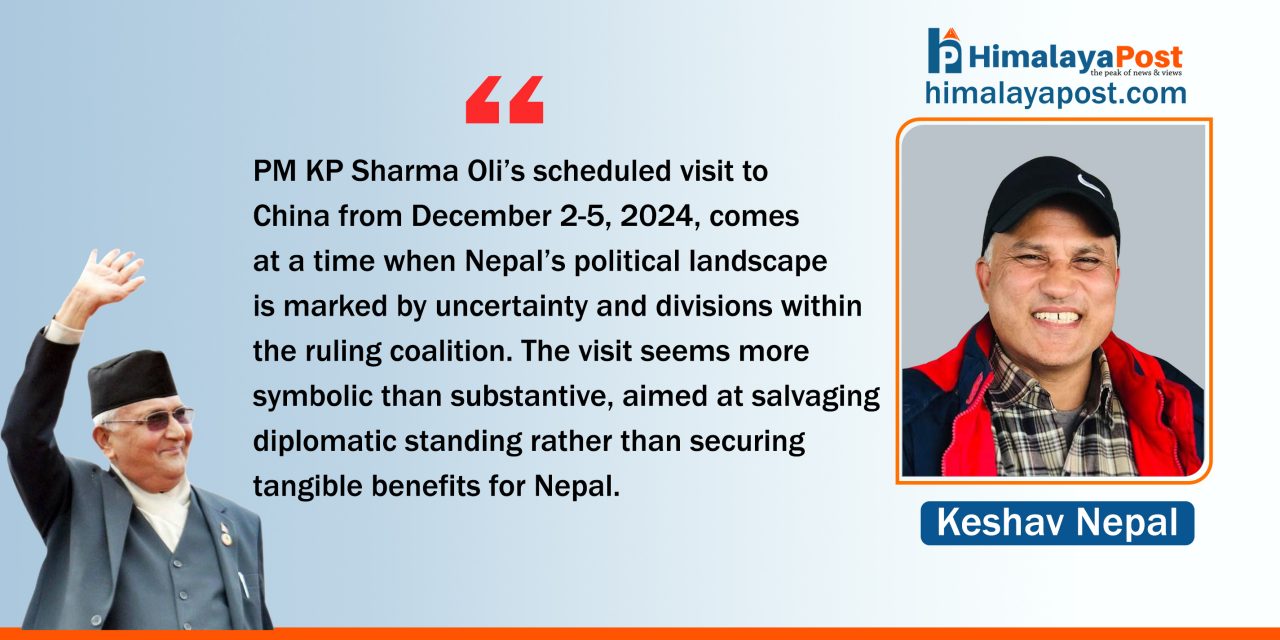– Keshav Nepal
Prime Minister KP Sharma Oli’s upcoming visit to China from December 2-5, 2024, appears strategically insignificant due to internal political constraints and external diplomatic challenges. As the head of a coalition government, Oli lacks the mandate to negotiate deals without the approval of the Nepali Congress, which firmly opposes loans and advocates for grants only. China’s reluctance to convert existing loans into grants and the controversy surrounding the Belt and Road Initiative (BRI) further diminish expectations. With strained India relations, the visit seems more symbolic than substantive, aimed at salvaging diplomatic standing rather than securing tangible benefits for Nepal.
Prime Minister KP Sharma Oli’s scheduled visit to China from December 2-5, 2024, comes at a time when Nepal’s political landscape is marked by uncertainty and divisions within the ruling coalition. Although foreign visits often carry the promise of strengthening bilateral relations and securing developmental aid, this particular trip appears to lack the strategic depth and backing necessary to achieve substantive outcomes. Several political and economic factors diminish its potential significance.
Lack of a Clear Mandate in a Coalition Government
Prime Minister Oli leads a coalition government, where the largest partner, the Nepali Congress (NC), wields significant influence over major policy decisions. Without the NC’s endorsement, Oli’s ability to negotiate and sign agreements with China is highly constrained. The coalition’s internal dynamics are such that any deal not explicitly approved by the NC would lack legitimacy and risk creating domestic political discord.
The Nepali Congress has already expressed its reservations about unfettered engagements with China, particularly concerning loans for infrastructure projects. This limits Oli’s leverage during his visit. Any agreements reached without coalition consensus could be short-lived, undermining their implementation and long-term viability.
Nepali Congress’s Stance: “No Loans, Only Grants”
A critical impediment to meaningful negotiations with China is the Nepali Congress’s firm stance that Nepal will accept only grants, not loans, for infrastructural development. This policy reflects growing concerns over debt sustainability and the perceived risks of falling into a debt trap, a situation that many other countries have faced under China’s Belt and Road Initiative (BRI). The Pokhara International Airport project serves as a cautionary tale. Despite repeated requests from Nepal, China has shown no willingness to convert the airport’s construction loan into a grant.
Given this precedent, it is unlikely that China will alter its financial approach for future projects. The expectation that Nepal could secure new grants from China is therefore unrealistic. Without the possibility of obtaining grants, the visit risks becoming a mere diplomatic formality rather than a productive engagement.
The Belt and Road Initiative: A Controversial Prospect
China’s interest in Nepal is closely tied to the BRI, a global infrastructure initiative that has sparked considerable debate in Nepal. Critics argue that participation in the BRI could entangle Nepal in a cycle of debt, jeopardizing its economic sovereignty. While the BRI offers significant infrastructure funding, the terms often involve loans with conditions that many see as onerous.
The skepticism surrounding the BRI has led to delays and hesitations in committing to projects under its umbrella. With no clear consensus in Nepal about the BRI’s benefits and risks, Oli’s discussions with China on this front are unlikely to yield concrete outcomes. Furthermore, the political cost of endorsing BRI projects without broader support could be high, both domestically and internationally.
Diplomatic Context: A Move to Save Face?
Oli’s visit to China also appears to be driven by a desire to salvage his diplomatic standing. His strained relationship with India, evidenced by multiple unreturned calls, underscores a growing isolation in regional diplomacy. India remains a crucial partner for Nepal, given historical, cultural, and economic ties. Oli’s pivot to China, under these circumstances, could be perceived as a face-saving measure rather than a strategic shift.
However, China’s response to Oli’s overtures may be lukewarm, given the lack of internal consensus within Nepal and the limited prospects for meaningful agreements. Diplomatic gestures alone are unlikely to yield substantial benefits without the necessary groundwork and political backing.
Conclusion: A Visit of Limited Utility
Prime Minister KP Sharma Oli’s upcoming visit to China is fraught with challenges that undermine its potential significance. The absence of a clear mandate from his coalition government, the Nepali Congress’s insistence on grants over loans, and China’s reluctance to alter its financial strategies all point to a visit with limited prospects for success. Moreover, the controversies surrounding the BRI and Oli’s diplomatic isolation further complicate the context.
Rather than resulting in groundbreaking agreements, the visit may serve as a symbolic gesture aimed at maintaining diplomatic ties. However, without concrete outcomes, it risks being viewed as a futile exercise. For Nepal to truly benefit from engagements with China, a unified domestic front and a clear strategic vision are imperative—elements currently lacking in the political equation.





